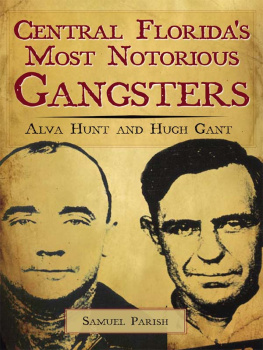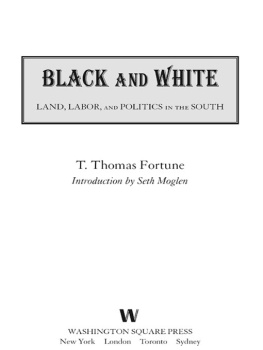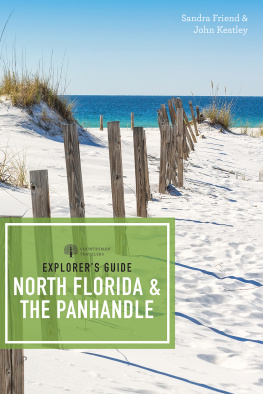2002 The University of North Carolina Press
All rights reserved
Manufactured in the United States of America
Designed by Heidi Perov
Set in Bell and Kuenstler Script
by Tseng Information Systems, Inc.
The paper in this book meets the guidelines for permanence and durability of the Committee on Production Guidelines for Book Longevity of the Council on Library Resources.
Library of Congress Cataloging-in-Publication Data
Baptist, Edward E.
Creating an Old South: Middle Floridas plantation frontier before the Civil War / Edward E. Baptist.
p. cm.
Includes bibliographical references and index.
ISBN 0-8078-2688-x (cloth: alk. paper)
ISBN 0-8078-5353-4 (pbk. : alk. paper)
1. FloridaHistory18211865. 2. Plantation lifeFloridaHistory19th century. 3. WhitesFloridaSocial conditions19th century. 4. Plantation ownersFloridaHistory19th century. 5. African AmericansFloridaSocial conditions19th century. 6. FloridaRace relations. 7. Social classesFloridaHistory19th century. 8. Frontier and pioneer lifeFlorida. 9. Land settlementSocial aspectsFloridaHistory19th century. 10. Migration, InternalUnited States History19th century. I. Title.
F315 .B37 2002
974.9'05dc21 2001053080
Cloth 06 05 04 03 02 54321
Paper 06 05 04 03 02 54321
e-ISBN: 978-0-807-86003-8
Acknowledgments
The long process of writing a book like this involves one in so many debts of kindness and assistance to other people that one cannot hope to repay them. One is in a sense bankrupt, bound to ones creditors by obligations that cannot be redeemed. At least that is what I hope, for my scheme is this: by remaining in their debt, I plan to remain linked to them. And thus I must first acknowledge my bankruptcy, my unpayable obligations of gratitude, in order to cement that relationship.
Any historian must begin by thanking those who preserve and make available the most basic building blocks of research: the archivists and librarians who have saved me countless times from error, confusion, and most of all, ignorance of some of the fantastic sources Ive been lucky enough to examine. David Coles and the staff of the Florida State Archives and Florida State Library alerted this (occasional) migrant to Middle Florida to many sources. David helped me repeatedly after I returned to Philadelphia, supplying xeroxes, citations, and suggestions. At the Jackson County Courthouse in Marianna, Florida, Robert Standland and Dale Herman helped me dig up records that I thought had burned a century and a half ago. For many years, Bill Erwin performed his own archival miracles in the Special Collections Department of the Perkins Library at Duke, matching scholars with sources, using files in his head that no computer could equal. The rest of the staff there, as well as Tim Pyatt, Shayera Tangri, John White, and the rest of the staff of the Southern Historical Collection at the University of North Carolinas Wilson Library also assisted me in countless ways. The staffs of the Georgia Historical Society and the Virginia Historical Society were also unfailingly polite and helpful. Finally, Walter Beyer of the Family History Center in Broomall, Pennsylvania, helped me utilize the genealogical resources of the Church of Jesus Christ of Latter-day Saints. Few scholars are aware that this organization has microfilmed county records from all over the United States, or that the church generously permits nonmembers to use these resources for their own genealogical or historical researches.
At Georgetown University, a group of extraordinary undergraduate teachers and advisersDavid Johnson, Alan Karras, John R. McNeill, and Marcus Redikerset my historical feet on the ground and taught me how to find and write my own way forward. Then, at the University of Pennsylvania, and the Pennsylvania (now McNeil) Center for Early American Studies, a number of mentors, teachers, and friends helped shape me into a professional historian. Im grateful for the assistance, advice, and examples of Roger Abrahams, Richard Beeman, Kathy Brown, Bob Engs, Nancy Farriss, Jeff Fear, Lynn Hunt, Walter Licht, Roderick McDonald, Charles Rosenberg, Mark Stern, Tom Sugrue, Mike Zuckerman, and for the Department of History in general for its years of financial support while I was a graduate student. Meanwhile, Val Riley and Gladyce Constantine always had quiet words of encouragement and confidence, in addition to making it possible for graduate students to navigate the channels of bureaucracy. I appreciate them very much, as I do Deborah Broadnaxwho did the same things, only more loudly.
I also want to acknowledge the assistance of the University of Miami, especially for the two Max Orovitz research grants that allowed me to conduct additional research and complete the writing of this book, and the General Research grant that enabled Richter Library to purchase important microfilms. During my first few years at Miami, tumultuous though they were at times, I developed as a scholar and teacher only with the assistance of numerous colleagues, students, and friends. Some were there every day; some put in precisely the right word at precisely the right time. Without each of them, Im sure that the last four years would have been much more difficult. In particular, I must thank Edmund Abaka, Ligia Aldana, Robin Bachin, Leslie Bow, Jeff Brosco, Bill Brown, Russ Castronovo, Charles Clency, Fred DAguiar, Edwidge Danticat, Lenny Del Granado, Marcia Evanson, Martha Few, Harry and Ruth Forgan, Jennifer Forsythe, Ken Goodman, Paul Hamburg, Kathy Harrison, Whittington Johnson, Jim Lake, Bob Levine, Bob Moore, Sandra Paquet, Rochelle Theo Pienn, Aldo Regalado, Don Spivey, Steve Stein, Kumble R. Subbawamy, Hugh and Pat Thomas, Ruthanne Vogel, and all my students.
In graduate school and elsewhere, a number of friends helped shape both my writing and my life, and I am happy to be able to acknowledge their comradeship, their hospitality, their brother- and sisterhood. They include: Luther Adams, Roseanne Adderley, Stephen Bumgardner and his family, Stephanie Camp, Kon Dierks, Leigh Edwards, Rhonda Frederick, Anne-Elizabeth Giuliani, Kali Gross, Jennifer Gunn, Beth Hillman, Tom Humphrey, Maurice Jackson, Hannah Joyner, Michael Kahan, Bob Kane, Rukesh Korde, Tim Lane, Edward Larkin, Bruce Lenthall, David Meyers, Liam Riordan, Sarah Russell, Randolph Scully, Kristen Stromberg, Phillip Troutman, Karim Tiro, Judy Van Buskirk, Justin Warf, and Rhonda Williams.
The following individuals read and commented on the entire manuscript at various stages, and it is much better, and less unwieldy, as a result of their generous efforts: Charles Bolton, Clark Cahow, Dan Dupre, Hugh Thomas, and an anonymous reader for the University of North Carolina Press. John Hope Franklin and John Lukacs provided timely encouragement. Others pitched in to read and comment on particular chapters, or papers and article manuscripts that became parts of various chapters, including Luther Adams, Stephanie Baptist, John Boles, Stephanie Camp, Jane Turner Censer, James Dorgan, Susan Gray, Steven Hahn, Tom Humphrey, Hannah Joyner, Edward Larkin, John Edwin Mason, Holly Mayer, Alida Metcalf, Marcus Rediker, Daniel Rodgers, William Warren Rogers, Sarah Russell, Chris Schroeder, Randolph Scully, Mitchell Snay, Neva Specht, Karim Tiro, Kirsten Wood, Bertram Wyatt-Brown, several anonymous readers for the





